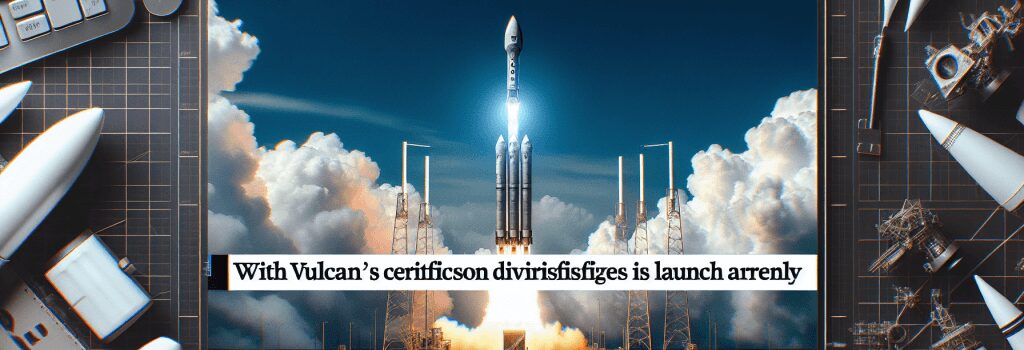With Vulcan’s Certification, Space Force Diversifies Its Launch Arsenal

The US Space Force has taken a significant step toward bolstering its launch capacity by certifying United Launch Alliance’s (ULA) Vulcan rocket for national security missions. This certification marks an important milestone that ends the Space Force’s sole reliance on SpaceX’s Falcon 9 and Falcon Heavy fleets, expanding the nation’s assured access to space and increasing redundancy in critical payload launches.
Certification Milestones and Process
According to Brig. Gen. Panzenhagen, program executive officer for Assured Access to Space, “Assured access to space is a core function of the Space Force and a critical element of national security.” ULA’s Vulcan rocket certification came after a lengthy, rigorous process, addressing over 52 specific certification criteria, more than 180 discrete tasks, 60 payload interface requirement verifications, 18 subsystem design and test reviews, alongside 114 hardware and software audits. Additionally, the certification process required two separate flight demonstrations before clearance was granted for the Department of Defense’s most sensitive missions.
Overcoming Technical Hurdles
The journey to certification was not without its setbacks. An explosion on a test stand in northern Alabama during the spring of 2023 delayed the first test flight while an anomaly in October 2024 further complicated matters. During the second test flight, a nozzle malfunction occurred on one of the Vulcan’s two side-mounted boosters. This event, attributed to a manufacturing defect, necessitated extensive reviews and additional testing.
ULA’s chief, Tory Bruno, confirmed that corrective actions had been implemented after isolating the root cause. A follow-up static-fire test at a Northrop facility in Utah in February verified that the adjustments were effective, allowing for a return to full hardware fabrication and further screening protocols. These modifications have not only resolved the booster issue but have also paved the way for enhanced reliability in subsequent launches.
Technical Deep Dive: Vulcan’s Engineering and Capabilities
The Vulcan rocket is a next-generation launch vehicle designed to meet the evolving demands of national security and commercial missions alike. With a modular design, robust engine configurations, and the flexibility to integrate varying payloads, Vulcan is engineered to compete in an arena historically dominated by legacy launch systems. The rocket features advanced propulsion systems, including the BE-4 engines, which provide improved performance and fuel efficiency compared to older engines. ULA’s focus on iterative design improvements ensures that the vehicle is well-equipped to handle the sophisticated requirements of modern space-based systems.
Manufacturing Challenges and Scaling Launch Cadence
Before certification, a longstanding concern among military and industry experts revolved around ULA’s ability to scale production. The rigorous certification review, combined with additional corrective measures, instilled additional oversight over manufacturing practices. Although initial projections for 2025 anticipated launching approximately two dozen vehicles (a mix of Atlas and Vulcan rockets), the current objective has been recalibrated to around a dozen launches. This strategy reflects a cautious, stepwise ramp-up, ensuring that every vehicle meets stringent reliability and performance metrics.
Experts suggest that once Vulcan demonstrates its operational stability in its national security missions, ULA could well expand its production capacities further, aligning with broader defense and commercial requirements. The phased approach aims to balance immediate mission needs with long-term manufacturing scalability and risk management.
Comparative Analysis: Vulcan versus Falcon Series
The certification of the Vulcan rocket represents a pivotal moment in the competitive landscape of launch services. While SpaceX’s Falcon rockets have garnered recent acclaim for their rapid turnaround times and high launch cadence, Vulcan introduces new advantages in resiliency and flexibility. Its advanced design and multi-faceted payload capability could provide mission planners increased options in the event of technical or scheduling disruptions with other service providers.
Furthermore, with Vulcan’s ability to support a variety of mission profiles—from commercial satellite deployments to critical national security payload insertions—ULA is well positioned to challenge incumbents, offering an alternative that reinforces the strategic diversity of U.S. space launch capabilities.
Upcoming Missions and Future Outlook
While Vulcan’s certification is a major achievement, its next mission is not immediately imminent. ULA is slated to first launch one of its remaining Atlas 5 boosters carrying Project Kuiper broadband satellites for Amazon, potentially as early as April. This will be succeeded by the two inaugural Vulcan national security missions, designated USSF-106 and USSF-87, with the first possible launch expected this summer.
Industry insiders remain cautious yet optimistic about ULA’s long-term plan to increase the launch cadence. Senior Air Force officials have previously raised concerns regarding manufacturing scale-up; however, ULA’s leadership believes that the comprehensive certification process resolves many of those issues. With rigorous reviews now completed, the focus shifts to operational launches and further refinements in production techniques.
Expert Opinions and Strategic Implications
Industry experts and defense analysts see this certification as a signal of broader shifts in the national space launch strategy. Diversifying the fleet not only mitigates risk associated with potential supply chain disruptions but also fosters healthy competition, driving innovation and cost-effectiveness among providers. As geopolitical tensions continue to underscore the strategic importance of space-based systems, having multiple certified launch platforms enhances U.S. national security posture.
In commentary on the topic, several aerospace engineers have noted that ULA’s rigorous certification process and subsequent operational launches will act as a benchmark for future multi-provider ecosystems in the space industry. The ability to ramp up production while ensuring top-tier reliability will determine the competitiveness of future launch systems both in commercial and defense sectors.
This expanded and technical overview underscores the importance of the Vulcan certification, projecting its impact across multiple areas of technological development, national security, and the global space race.
Source: Ars Technica